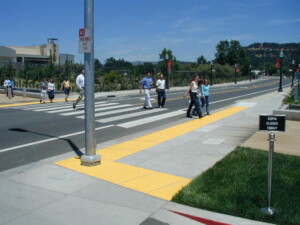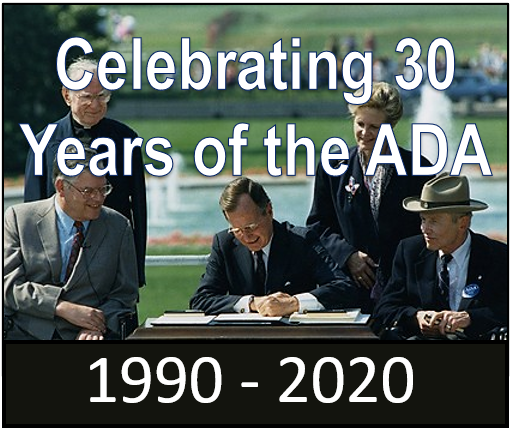Public Right-of-Way Accessibility Guidelines (PROWAG) by Kerwin Lee, AIA

After over 20-years in the making, the Access Board has published new guidelines under the Americans with Disabilities Act (ADA) and the Architectural Barriers Act (ABA) that address access to sidewalks and streets, crosswalks, curb ramps, pedestrian signals, on-street parking, and other components of the “public right-of-way”. These guidelines also review and include shared use paths, which are designed primarily for use by bicyclists and pedestrians for transportation and recreation purposes.

The history of the PROWAG document goes back over 20 years. In the creation of the PROWAY Rules and Guidelines is where Detectable Warnings were removed from the ADA Standards. It was later retained for curb ramps and transit stops. California has expanded the use of Detectable Warnings beyond what the ADA Standards and even the PROWAY guidelines have recommended.
The following is a chronological history of the Boards efforts with the associated document history:
Background
- October 20, 1999 – The Board organizes the Public Rights-of-Way Access Advisory Committee.
- January 10, 2001 – The Public Rights-of-Way Access Advisory Committee submits its report to the Board.
- June 17, 2002 – The Board releases draft guidelines for public comment.
- November 23, 2005 – The Board releases revised draft guidelines for purposes of gathering information for a cost analysis.

- March 28, 2011 – The Board issues notice of proposed rule on Shared Use Path Accessibility Guidelines.
- December 5, 2011 – The Board issues notice reopening proposed rule for public comment.
- February 13, 2013 – The Board publishes a Proposed Draft Accessibility Guidelines for the Public Right-of-Way in its rulemaking on public right-of-way, along with supplemental notice to address shared use paths in its rulemaking on public right-of-way.
- August 8, 2023 – The Board publishes final rule in the Federal Register.
 These guidelines inform federal, state, and local government agencies on how to make their pedestrian facilities, such as sidewalks, crosswalks, shared use paths, and on-street parking, accessible to people with disabilities. Some of the PROWAG guidelines and requirements are already found in the current 2010 ADAAG Standards and the California Building Code (CBC). Requirements for curb ramps, transit stops and walkways, we already apply to the built environment in the projects we work on.
These guidelines inform federal, state, and local government agencies on how to make their pedestrian facilities, such as sidewalks, crosswalks, shared use paths, and on-street parking, accessible to people with disabilities. Some of the PROWAG guidelines and requirements are already found in the current 2010 ADAAG Standards and the California Building Code (CBC). Requirements for curb ramps, transit stops and walkways, we already apply to the built environment in the projects we work on.
The PROWAG covers the minimum scoping and technical requirements for various spaces and elements in the public right-of-way, such as pedestrian access routes, which ensure the accessibility of sidewalks, including alternate access routes when the main route is closed for maintenance or construction. Other highlights in the requirements include accessible pedestrian signals, curb ramps and blended transitions, detectable warning surfaces, crosswalks at roundabouts, on-street parking, transit stops, and street furniture. In addition, the guidelines address shared use paths, which are designed primarily for use by bicyclists, pedestrians and other authorized motorized and non-motorized users for transportation purposes and recreation purposes.
PROWAG guidelines are not legally enforceable until they are adopted by Department of Justice (DOJ) or Department of Transportation (DOT) regulations, and by the four standard-setting agencies under the Architectural Barriers Act. If and when they are adopted and made enforceable is unknown.
 When PROWAG becomes enforceable, PROWAG is specifically for “Public-Right-of-Way”,normally outside of the project areas, we will need to apply these when it becomes part of the project, as many developments go outside the property into the public way. What designers should lookout for are elements that are addressed in the PROWAG, but not in either the ADA Standards or State Code. Once PROWAG becomes enforceable, Building Departments will not be enforcing the PROWAG on a local basis, enforcement of the Federal Standards is by the DOJ, there may be a legal binding issue here for one to be complying with ALL of the standards for disabled access. This may become a legal or court issue. It would be worth your while to look over the latest PROWAY publications and become familiar with what it addresses.
When PROWAG becomes enforceable, PROWAG is specifically for “Public-Right-of-Way”,normally outside of the project areas, we will need to apply these when it becomes part of the project, as many developments go outside the property into the public way. What designers should lookout for are elements that are addressed in the PROWAG, but not in either the ADA Standards or State Code. Once PROWAG becomes enforceable, Building Departments will not be enforcing the PROWAG on a local basis, enforcement of the Federal Standards is by the DOJ, there may be a legal binding issue here for one to be complying with ALL of the standards for disabled access. This may become a legal or court issue. It would be worth your while to look over the latest PROWAY publications and become familiar with what it addresses.
Note: The Final Guidelines for PROWAG are still in development. The Guidelines are more like a set of Building Standards, with code language and diagrams.
Additional Resources
- Final Regulatory Impact Analysis
- Accessible Sidewalks Video Series
- Public Rights-of-Way Access Advisory Committee (PROWAAC) Special Report on Planning and Design for Alterations
- Detectable Warnings Update (March 2014)
- Department of Justice/Department of Transportation Joint Technical Assistance on the Title II of the Americans with Disabilities Act Requirements to Provide Curb Ramps when Streets, Roads, or Highways are Altered through Resurfacing Statement and Supplemental Q&A
- Visual Detection of Detectable Warning Materials by Pedestrians with Visual Impairments (Board funded research)
Comments from Jonathan Clark’s:
I concur with Kerwin that the catch for most of us will be when our projects get conditioned to improve the public right-of-way. My inclination is that this will fall to the civil engineer, but it is helpful to be aware of these future requirements to be able to provide balance and context to the project team.



Responses